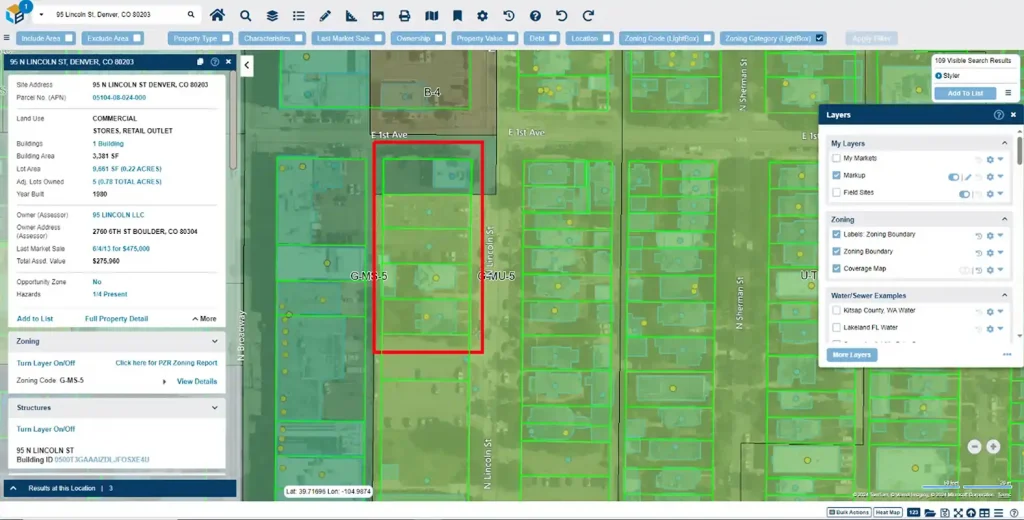As cities grapple with housing shortages, zoning overlays are emerging as a strategic tool to encourage high-density development and address the growing demand for affordable housing. By allowing for flexible land use regulations, often accompanied by affordability requirements, zoning overlays empower cities to optimize available space, boost density, reduce the dependance on cars combatting congestion, and promote more diverse communities.
The Role of Zoning Overlays
An overlay zone is a zoning designation applied over one or more previously established zoning districts, establishing either stricter requirements or “allowed by right” zoning laws. According to LightBox data, approximately 20% of sites across the U.S. have multiple zoning designations.

Zoning overlays serve many purposes, ranging from preserving historic districts to protecting environmentally sensitive areas and promoting public transportation. Additionally, they offer developers flexibility to explore mixed-use developments to revitalize urban areas, reduce traffic congestion and promote economic opportunities. Research shows that one of the significant applications of zoning overlays is addressing housing shortages, which has been particularly impactful in cities across the U.S.
Transit-Oriented Overlays to Combat Housing Shortages
In nearly 75% of the country’s metropolitan areas, a shortage of housing production persists. According to LightBox RCM data, multifamily listings have increased nationwide from 23% in 2019 to 32% in 2023, a rise that maximizes land use efficiency and allows for more residents within the same area. Many cities across the country are using zoning overlays to promote such developments along public transportation corridors.
In Madison, WI, the city approved the Transit Oriented Development Overlay, which allows every residential lot within a quarter mile of the Bus Rapid Transit (BRT) routes to incrementally increase the density allowances. Neighborhoods restricted to single-family homes can begin to accommodate duplexes, while areas limiting multifamily buildings to three stories have increased the height allowance to four stories.
In Wayland, Massachusetts, the city is embracing an innovative approach to comply with the state’s new multifamily zoning law linked to the Massachusetts Bay Transit Authority (MBTA). The MBTA Communities Multi-Family Zoning Act, which aims to tackle the state’s housing shortage and promote public transportation use, affects 177 cities within the MBTA service area, which Wayland is a part. The city is responding by creating four zoning overlays, which will allow multifamily developments “by right,” paving the way for denser housing developments. The town has been actively engaging in meetings to vote on the Act.
Taking a Bite out of the Affordable Housing Crisis with Overlays
Zoning overlays can specifically target affordable housing initiatives by designating certain areas for development with affordability requirements. These requirements may include provisions for a percentage of units solely for low- and moderate-income households or incentives for developers to incorporate affordable housing options within their projects.
The city of Cambridge- a suburb of Boston- has had a 100% affordable housing overlay in effect since 2020. This overlay permits increased housing density in exchange for permanent affordability. The 2023 amendments to the overlay grant taller height allowances and less-restrictive setback requirements for developments marked as affordable housing. Cambridge’s proactive approach is fostering efficient land use and encouraging affordable housing development.
In Denver, Colorado’s case, the city is removing overlays to streamline multifamily development in the future. In one such case, the Lincoln Street and First Avenue project, the developer received approval to rezone five parcels–including a single-story commercial building, a parking lot, a single-family home, and a duplex–and remove existing overlays to make way for a seven-story mixed-use building, incorporating retail and a mix of market-rate and affordable housing.

While the affordable housing requirement is not overwhelming–the developer must rent only 10% of the units to households earning 60% of the area’s median income– it demonstrates how cities and towns can proactively address the growing affordability crisis and ensure that housing remains accessible to residents across diverse income brackets.
As cities navigate housing shortages, the role of zoning overlays will continue to evolve. While zoning overlays can fulfill various community objectives beyond boosting housing density like historic preservation and environmental conservation, an increasing number of cities and municipalities are leveraging this zoning approach to address the housing affordability crisis and the overall shortage of housing.
